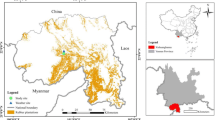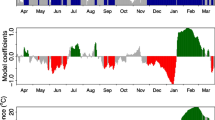Abstract
Rubber powdery mildew disease (Oidium heveae) is a serious threat to natural rubber production (Hevea brasiliensis) in some rubber developing regions of the world. Both phenological- and meteorological-related factors have been reported influencing the powdery mildew disease. However, few studies have investigated the effects of both phenological- and meteorological-related factors on the disease. The objective of this study is to quantify the contributions of phenological- and meteorological-related factors to affect the disease. We used the partial least squares (PLS) regression method to comprehensively quantify the effects of thirty-five phenological related factors and six meteorological factors on the infection level of powdery mildew of rubber trees over 9-year records (2003–2011). The relative contributions of significant factors were further investigated by the variation partition analysis. We found that the most influential variables were the mean temperature during winter and the duration of leaf development to maturation which explained 32 and 26% of the variations in the infection level. We found the controlling role of winter mean temperature, for the first time, on the infection level of powdery mildew. The controlling role of winter temperature may have directly increase the infection level when winter temperature is high and indirectly increase the infection level through prolonging the duration of leaf development to maturation, although the duration itself had smaller influences. We detected a warming trend of the winter temperatures from 2003 to 2011, which indicates that the infection level of powdery mildew will be increased if the winter warming continues.







Similar content being viewed by others
References
Bowers JE (1990) Natural rubber-producing plants for the United States. National Agricultural Library, Beltsville
Cao M, Zou XM, Warren M, Zhu H (2006) Tropical forests of Xishuangbanna, China. Biotropica 38:306–309. https://doi.org/10.1111/j.1744-7429.2006.00146.x
Chen Y, Zhu Y, Zhang J, Zhou S, Zhang L (2019) Study on dynamic forecast of the suitability degree of rubber powdery mildew weather condition in Yunnan Province. J Catastrophology 34:148–152
Dixon P (2003) VEGAN, a package of R functions for community ecology. J Veg Sci 14:927–930
Fang J, Tu M, Cai H, Hu Y, Sun A, Hua Y, Huang H (2013) Resistance identification to powdery mildew of various rubber tree clones. Guangdong Agric Sci 15:88–90
Guo L, Dai J, Ranjitkar S, Xu J, Luedeling E (2013) Response of chestnut phenology in China to climate variation and change. Agric For Meteorol 180:164–172. https://doi.org/10.1016/j.agrformet.2013.06.004
Guo l, Cheng J, Luedeling E, Koerner SE, He JS, Xu J, Gang C, Li W, Luo R, Peng C (2017) Critical climate periods for grassland productivity on China’s Loess Plateau. Agric Forest Meteorol 233:101–109
Guyot J, Le Guen V (2018) A Review of a Century of Studies on South American Leaf Blight of the Rubber Tree. Plant Dis 102:1052–1065. https://doi.org/10.1094/pdis-04-17-0592-fe
Guyot J, Omanda EN, Ndoutoume A, Otsaghe A-AM, Enjalric F, Assoumou H-GN (2001) Effect of controlling Colletotrichum leaf fall of rubber tree on epidemic development and rubber production. Crop Prot 20:581–590. https://doi.org/10.1016/S0261-2194(01)00027-8
Guyot J, Cilas C, Sache I (2008) Influence of host resistance and phenology on South American leaf blight of the rubber tree with special consideration of temporal dynamics. Eur J Plant Pathol 120:111–124. https://doi.org/10.1007/s10658-007-9197-6
Hallé F, Martin R (1968) Etude de la croissance rythmique chez l’hévéa (Hevea brasiliensis Müll.-Arg. Euphorbiacées Crotonoïdées). Adansonia, série 2, 8: 475–503.
Li Z, Fox JM (2012) Mapping rubber tree growth in mainland Southeast Asia using time-series MODIS 250 m NDVI and statistical data. Appl Geogr 32:420–432. https://doi.org/10.1016/j.apgeog.2011.06.018
Li YW, Xia YJ, Li HY, Deng XB, Sha LQ, Li B, Lin LX, Cao M (2016) Accumulated impacts of sulfur spraying on soil nutrient availability and microbial biomass in rubber plantations. Clean-Soil Air Water 44:1001–1010. https://doi.org/10.1002/clen.201400397
Liu X, Li B, Cai J, Zheng X, Feng Y, Huang G (2018) Colletotrichum species causing anthracnose of rubber trees in China. Sci Rep 8:10435. https://doi.org/10.1038/s41598-018-28166-7
Liyanage AS, Jayasinghe CK, Liyanage NIS, Jayaratne AHR (1986) Corynespora Leaf spot disease of rubber (Hevea brasiliensis)—a new report. J Rubber Res Inst Sri Lanka 65:47–50
Liyanage KK, Khan S, Brooks S, Mortimer PE, Karunarathna SC, Xu JC, Hyde KD (2018) Morpho-Molecular Characterization of Two Ampelomyces spp. (Pleosporales) Strains Mycoparasites of Powdery Mildew of Hevea brasiliensis. Front Microbiol 5. https://doi.org/10.3389/fmicb.2018.00012
Liyanage KK, Khan S, Ranjitkar S, Yu H, Xu J, Brooks S, Beckschäfer P, Hyde KD (2019) Evaluation of key meteorological determinants of wintering and flowering patterns of five rubber clones in Xishuangbanna, Yunnan, China. Int J Biometeorol 63:617–625. https://doi.org/10.1007/s00484-018-1598-z
Luedeling E (2017) chillR: Statistical methods for phenology analysis in temperate fruit trees. R Package Version 0.66. , http://cran.r-project.org/package=chillR (accessed on 20 May 2018).
Luedeling E, Gassner A (2012) Partial least squares regression for analyzing walnut phenology in California. Agric For Meteorol 158–159:43–52. https://doi.org/10.1016/j.agrformet.2011.10.020
Luedeling E, Kunz A, Blanke MM (2013) Identification of chilling and heat requirements of cherry trees-a statistical approach. Int. J. Biometeorol 57:679–689
Marcais B, Desprez-Loustau ML (2014) European oak powdery mildew: impact on trees, effects of environmental factors, and potential effects of climate change. Ann For Sci 71:633–642. https://doi.org/10.1007/s13595-012-0252-x
Marcais B, Piou D, Dezette D, Desprez-Loustau ML (2017) can oak powdery mildew severity be explained by indirect effects of climate on the composition of the erysiphe pathogenic complex? Phytopathology 107:570–579. https://doi.org/10.1094/phyto-07-16-0268-r
Mevik BH, Wehrens R, Liland K (2016) PLS: Partial least squares and principal component regression. R Package Version 2(6) http://cran.r-project.org/package=pls. (accessed on 20 May 2018)
Nychka D, Furrer R, Paige J, Sain S (2017) Fields: Tools for Spatial Data. R Package Version 9:6 https://cran.r-project.org/package=fields (accessed on 20 May 2018)
Pearse IS, Karban R (2013) Leaf drop affects herbivory in oaks. Oecologia 173:925–932. https://doi.org/10.1007/s00442-013-2689-5
Plant Protection Research Institute of South China Academy of Tropical Crops Sciences (PPRI, SCATCS) (1983) Epidemic Pattern of Rubber Powdery Mildew in 1959 - 1981. Chin J Trop Crop Res 4:75–84
Plant Protection Research Institute of South China Academy of Tropical Crops Sciences (PPRI, SCATCS) (1985) Rubber Powdery Mildew Forecasting in 1960 -1980. Chin J Trop Crop Res 6:51–56
Pornsuriya C, Chairin T, Thaochan N, Sunpapao A (2020) Identification and characterization of Neopestalotiopsis fungi associated with a novel leaf fall disease of rubber trees (Hevea brasiliensis) in Thailand. J Phytopathol 168:416–427
Priyadarshan P (2011) Biology of Hevea rubber. CABI International, Wallingford
Priyadarshan PM, Hoa TTT, Huasun H, de Gonçalves PS (2005) Yielding Potential of Rubber (Hevea brasiliensis) in Sub-Optimal Environments. J Crop Improv 14:221–247. https://doi.org/10.1300/J411v14n01_10
R Core Team (2017) R: A Language and environment for statistical Computing. R Foundation for Statistical Computing, Vienna, Austria. https://www.R-project.org/
Shao Z, Hu Z (1984) Powdery Mildew infestation investigation on different leaf phenological stages of rubber trees. Yunnan Trop Technol 1:1–5
Shao Z, Zhou J, Chen J, Li C, Meng Y (1996) Powdery mildew epidemic rate of rubber trees Yunnan. Trop Technol 19:2–12
Warren-Thomas E, Dolman PM, Edwards DP (2015) Increasing demand for natural rubber necessitates a robust sustainability initiative to mitigate impacts on tropical biodiversity. Conserv Lett 8:230–241. https://doi.org/10.1111/conl.12170
Warren-Thomas EM, Edwards DP, Bebber DP, Chhang P, Diment AN, Evans TD, Lambrick FH, Maxwell JF, Nut M, O'Kelly HJ, Theilade I, Dolman PM (2018) Protecting tropical forests from the rapid expansion of rubber using carbon payments. Nat Commun 9:911. https://doi.org/10.1038/s41467-018-03287-9
Xiao C (2010) Comparative studies of comprehensive prevention and control for rubber powdery mildew. China Trop Agric 06:56–58
Yu Z, Wang S (1988) Epidemic processes and structure of rubber powdery mildew. Chin J Trop Crop 1:83–89
Yu Z, Wang S, Zhou C (1980) Rubber powdery mildew epidemic factors and control analysis, and the assessment in 1979. Chin J Trop Agric Res 2:89–99
Yu Z, Wang S, Zhou C (1985) Changing patterns of Spores of Oidium Heveae. Chin J Trop Crop Res 2:34–40
Yu H, Hammond J, Ling S, Zhou S, Mortimer PE, Xu J (2014) Greater diurnal temperature difference, an overlooked but important climatic driver of rubber yield. Ind Crop Prod 62:14–21. https://doi.org/10.1016/j.indcrop.2014.08.001
Zhai D-L, Yu H, Chen S-C, Ranjitkar S, Xu J (2019) Responses of rubber leaf phenology to climatic variations in Southwest China. Int J Biometeorol 63:607–616. https://doi.org/10.1007/s00484-017-1448-4
Zhai D-L, Wang J, Thaler P, Luo Y, Xu J (2020) Contrasted effects of temperature during defoliation vs. refoliation periods on the infection of rubber powdery mildew (Oidium heveae) in Xishuangbanna, China. Int J Biometeorol 64:1835–1845. https://doi.org/10.1007/s00484-020-01969-y
Zhang J, Cao M (1995) Tropical forest vegetation of Xishuangbanna, SW China and its secondary changes, with special reference to some problems in local nature conservation. Biol Conserv 73:229–238. https://doi.org/10.1016/0006-3207(94)00118-a
Zhang H, Yang S, Li W, Hu Y, Bai X (2009) Epidemic pattern of rubber powdery mildew in Dehong In: The 2009 annual conference of Yunnan tropical crops Xishuangbanna, Yunnan, China. pp 12
Zhu H, Cao M, Hu HB (2006) Geological history, flora, and vegetation of Xishuangbanna, southern Yunnan, China. Biotropica 38:310–317. https://doi.org/10.1111/j.1744-7429.2006.00147.x
Zomer RJ, Trabucco A, Wang M, Lang R, Chen H, Metzger MJ, Smajgl A, Beckschäfer P, Xu J (2014) Environmental stratification to model climate change impacts on biodiversity and rubber production in Xishuangbanna, Yunnan, China. Biol Conserv 170:264–273. https://doi.org/10.1016/j.biocon.2013.11.028
Acknowledgments
This work was financially supported by the National Natural Science Foundation of China (NSFC) and the Belmont Forum Collaborative Research Action “Mountains as Sentinels of Change -2015” (No. 41661144001), and also by the Key Research Program of Frontier Sciences, the Chinese Academy of Sciences (QYZDY-SSW-SMC014). This work is also supported by Key Research Project (No. 2017YFC0505101)”. This work is also supported by a visiting scholar grant to Deli Zhai to the University of Northern Arizona in 2017–2018 from the Kunming Institute of Botany. The authors would like to thank Dr. Wang Jing from East China Normal University for her help on the figures of early version and for her supports in performing the VPA analysis.
Author information
Authors and Affiliations
Corresponding authors
Additional information
Publisher’s note
Springer Nature remains neutral with regard to jurisdictional claims in published maps and institutional affiliations.
Supplementary Information
ESM 1
(DOCX 27153 kb)
Rights and permissions
About this article
Cite this article
Zhai, DL., Thaler, P., Luo, Y. et al. The powdery mildew disease of rubber (Oidium heveae) is jointly controlled by the winter temperature and host phenology. Int J Biometeorol 65, 1707–1718 (2021). https://doi.org/10.1007/s00484-021-02125-w
Received:
Revised:
Accepted:
Published:
Issue Date:
DOI: https://doi.org/10.1007/s00484-021-02125-w




